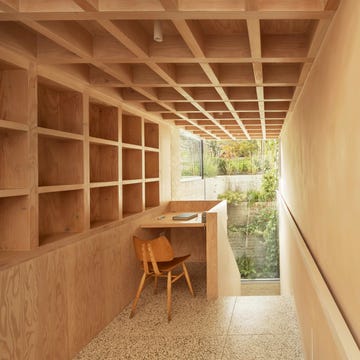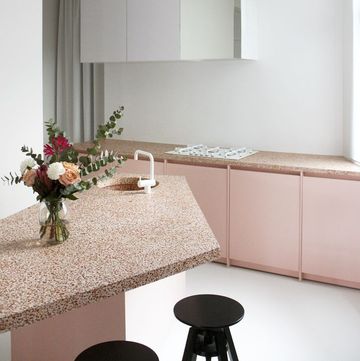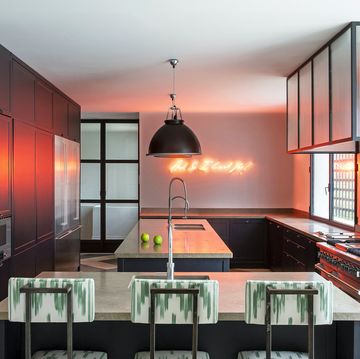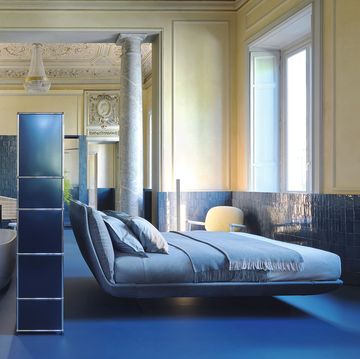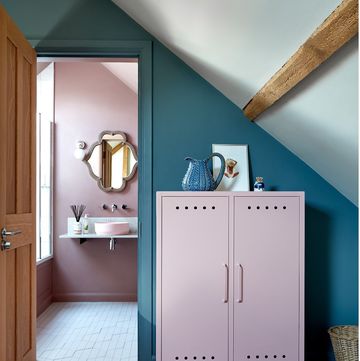Should you lay out your lounge according to strict rules of symmetry? Or is a relaxed, unstructured vibe more your style? We asked designers on both sides of the debate to share the benefits of their approach, plus the tips you need to know. It’s time to pick your side…
Symmetrical style
For some, a formal sitting room, with furniture arranged in a strictly symmetrical fashion, is the essential foundation for sophisticated design. ‘There is something deep in our subconscious that connects with a formally laid out, symmetrically designed living room; it just works really well,’ says Siobhan Kelly, associate director at David Collins Studio, a design powerhouse known for its ordered approach.
Symmetry has been a fundamental building block of design for millennia. It comes from the Greek word symmetros, and architects from the ancient Greeks to the Renaissance (plus all periods in between and beyond) have favoured the formality of a mirrored design, with furniture placed on either side of a central axis according to precise ratios of height, width and proportion.
What's everyone reading?
Nature designs in this way, too – picture the wings of a butterfly. ‘We are constantly exposed to forms of symmetry,’ Kelly adds. ‘It’s a fundamental part of our lives. When you walk down the aisle of a baroque-style church and you reach the point where the left and the right axes meet – it is a special moment, even if you’re not aware of the reason why.’
Because symmetry is so embedded in our world, proponents of this approach believe that the brain relaxes when entering a room arranged with mirror-image sofas and precisely matching side tables and lamps. Just like children, we all need boundaries.
‘Symmetry exerts an element of order and control,’ agrees architect Richard Parr. ‘It creates simple and unquestionable rigour, around which life can unfold.’ Interior designer Bryan O’Sullivan is also a fan: ‘I’m personally so drawn to symmetry; I have a natural preference for everything to be in the correct order.’
Three rules for a symmetrical sitting room
Lovers of structure will appreciate these designer guidelines for interior layouts
1 Choose your central axis. ‘Think about the big focal moments in a room, or where your eye falls first, and imagine a line drawn towards that through your room,’ Kelly advises. ‘It might be directed at a fireplace or other architectural feature,’ adds O’Sullivan.
2 It’s not just the furniture you should consider but lighting, too, according to O’Sullivan. ‘Have symmetrically positioned lamps around the room to give a nice distribution of diffused light,’ he says.
3 Don’t become a slave to your tape measure. ‘It is about the mind’s perception and lots of factors can play into this, from natural light to orientation, views, windows and door positions,’ says Parr.
Asymmetrical interiors
It is the promise of drama that designers Charlotte Rey and Duncan Campbell of Campbell-Rey say they find so attractive about an asymmetrical lounge. ‘For us, entering a room should feel like a transportive moment, where you continually discover details,’ Rey says.
‘Asymmetry is the key to creating this symphony – the eye picks up on the off-kilter moments.’
Asymmetry creates a freedom, both for the designer and the occupant. ‘When furniture in a living room is symmetrical and totally aligned, such as a perfectly dressed sofa, it can seem very rigid,’ believes interior designer James Thurstan Waterworth. ‘Subconsciously, it can feel very uncomfortable if you break that alignment by sitting down and interrupting a set scheme.’
By comparison, a lack of formal structure can be inviting. ‘Even if a living room is quite grand, I want there to be a feeling of welcoming informality,’ says interior designer Jessica Summer.
This approach can also feel more relevant to the way we live and decorate through the years. ‘My favourite type of house is one that has been put together over time and is layered with pieces from different generations,’ Thurstan Waterworth says. ‘A 20th-century armchair sits comfortably next to an inherited 19th-century Howard & Sons chair.’ This kind of layering of different heritage furniture is what Campbell and Rey call ‘cultural asymmetry’. ‘It creates a dialogue between the pieces, which we love,’ Campbell explains.
It can also be a practical way to dress a room. ‘One chair may need to be at an angle on one side of the room if there is not enough depth to the space, for example,’ says Summer. Or, if one is working with a basic rectangular or square lounge, ‘sometimes an asymmetrical layout can make it,’ adds interior designer Tamsin Johnson.
An effect of asymmetry is that nothing feels permanent or stale – all pieces can move or be subbed in and out. ‘Asymmetry allows for a pleasing element of surprise,’ Summer agrees. ‘I don’t like designs to be too strict – it doesn’t reflect how most people live.’
Three tips for creating an asymmetrical living room
Asymmetry doesn’t mean anything goes, there are pointers to keep in mind
1 Avoid even pairings of furniture and lighting. ‘I always like things in odd numbers,’ says Thurstan Waterworth. ‘It just feels better.’
2 Add a surprising colour. ‘Everything can be the same shape and readily symmetrical, but using odd colours will create the contrast you need,’ Thurstan Waterworth also advises.
3 Still consider balance – it’s important, even in an asymmetrical scheme. ‘For example,’ says Summer, ‘if you have a large picture on one wall and a smaller mirror on the opposite side, it might need a dark, heavy frame and a lamp underneath for equilibrium.’








